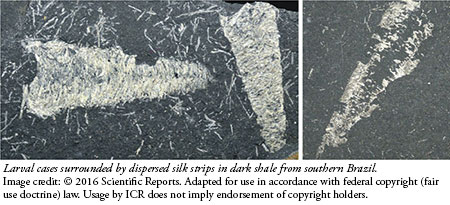Numerous amazing fossils supposedly millions of years old contain original, non-mineralized biomolecules like collagen, elastin, ovalbumin, DNA, laminin, melanin, hemoglobin, and chitin.1 A new study presents evidence suggesting this list should now include silk.
Brazilian and Polish researchers described what look like caddisfly larvae silk structures in layered shale rocks from southern Brazil. The white silk-like strands stand out from the surrounding dark gray shale. The authors' results appear in the online journal Scientific Reports.2 Known as underwater engineers, some species of caddisfly larvae spin special sticky silk homes to which they attach organic debris for camouflage. The fossilized caddisfly casings also had ancient debris attached to them.
 In other words, it looks like ancient caddisfly larvae took exactly the same approach to underwater home construction as their living versions. If so, then how did these creatures manage to resist evolutionary changes over 295 million supposed years? These fossils also show that caddisflies still have no known evolutionary ancestor. It looks instead like these tiny creatures have simply kept the same attributes God gave them in the beginning.
In other words, it looks like ancient caddisfly larvae took exactly the same approach to underwater home construction as their living versions. If so, then how did these creatures manage to resist evolutionary changes over 295 million supposed years? These fossils also show that caddisflies still have no known evolutionary ancestor. It looks instead like these tiny creatures have simply kept the same attributes God gave them in the beginning.
The Scientific Reports study authors analyzed element abundances within what they called the "silk-like material." They compared those to elements found in the debris layer just outside the white silky strands. Their analysis revealed stark differences. The "silk-like material" is a unique substance. But is that substance a mineral that might last for hundreds of millions of years, or an organic molecule with a far shorter shelf-life?
Their analysis showed abundant sulphur, calcium, and oxygen within the white silk substance. Standard amino acids that make up proteins have oxygen and sulphur, but not calcium atoms. But today's caddisfly larvae silk proteins use lots of calcium. A 2010 caddisfly study found that the insect's silk production uses a unique process called "calcium crossbridging."3 They secrete negatively charged silk proteins that interact with positively charged calcium ions. This electrostatic interaction repels water so they can form well-structured, sticky silks while living underwater. It's an amazing design. How could this calcium crossbridging process have merely evolved? Where are the transitional steps?
The Scientific Reports study included electron microscope images of the silk-like material. They show stringy, branching bands with sizes and shapes very similar to modern caddisfly larvae silk.4
All this evidence suggests that these researchers may well have examined leftover original silk proteins. And yet, decay experiments show that proteins do not last one million years. If future research confirms these white caddisfly larvae casings as original silk proteins, then scientists set on conventional age assignments will face a new challenge explaining how actual strands of delicate silk could last almost 300 million years.
On the other hand, a discovery of original silk in fossils would confirm a biblical view of world history that interprets these caddisfly larvae as Noah's Flood deposits. Speaking of which, the Scientific Reports study authors wrote,
The cases were collected in the 1.1 m [3.6 ft.] thick fossiliferous black shale that also contains hexactinellid sponges, brachiopods, gastropods, bivalves, crustaceans, actinopterygian fishes, coelacanth scales, shark teeth, conodont elements, scolecodonts, insects, as well as coprolites and plant fragments. Such a fossil assemblage, and especially the presence of terrestrial elements such as sporomorphs, plant remains and insects, point to a marine environment close to land.
What strange event could have mixed ocean with land creatures? Catastrophic flooding during Noah's 600th year would have jumbled land and sea with mud, just as in this Brazilian deposit. And the resulting layered shales, at only thousands of years old, could still contain original silk proteins.5
References
- See references in Thomas, B. 2015. Original Biomaterials in Fossils. Creation Research Society Quarterly. 51: 234-247.
- Mouro, L. D. et al. 2016. Larval cases of caddisfly (Insecta: Trichoptera) affinity in Early Permian marine environments of Gondwana. Scientific Reports. 6 (19215).
- Steward, R. J. and C. S. Wang. 2010. Adaptation of Caddisfly Larval Silks to Aquatic Habitats by Phosphorylation of H-Fibroin Serines. Biomacromolecules. 11 (4): 969-974.
- Compare Figure 4 in Reference 2 with Figure 1 in: Addison, J. B. et al. 2013. β-Sheet Nanocrystalline Domains Formed from Phosphorylated Serine-Rich Motifs in Caddisfly Larval Silk: A Solid State NMR and XRD Study. Biomacromolecules. 14 (4): 1140-1148.
- Their water-resistant chemical structure may help explain why these silk proteins may have lasted for thousands of years. Some dinosaur bones contain collagen protein, which also does not dissolve in water. Insoluble proteins seem to better resist microbial degradation.
*Mr. Thomas is Science Writer at the Institute for Creation Research.
Article posted on February 19, 2016.













